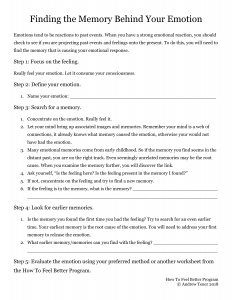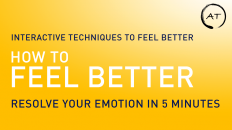As we’ve seen, emotions are reactions to the past. Every emotion is an association of a past event and feeling.
In order to change any incorrect assumptions behind an emotion, you need to remember what assumptions you are making. Basically, in order to feel better, you must be able to revisit the memory behind the emotion.
To help you, I’ve created a worksheet you can print out with the steps. 
Finding the Memory Behind an Emotion Worksheet by Andrew Tener
The following technique is the cornerstone of emotional understanding. The better you are at finding the core memory of an emotion, the easier it will be for you to feel better.
- Begin by choosing a feeling you want to understand.
- Focus on the feeling. The feeling is connected to the memory in your mind. Amplify the feeling, let it take over your whole consciousness.
- Whatever the first memory that pops into your head is, go to that.
- What is the memory? Is the feeling present in the memory?
- If not, try again.
- If the feeling is in the memory, reach for an even earlier memory.
- When you have found the earliest memory with feeling, you have discovered the source of the emotion.
Finding the memories may be difficult at first. But you will get the hang of it.
It’s really important that you trust your mind. You mind must do the work for you. It is a network of connections between related memories and feelings. Even if a memory does not seem related at first, dig deeper into the memory.
There isn’t guessing or logic involved in finding memories. You just need to let your mind follow the feeling, and you need to listen to what your mind tells you.
When you have this exercise down, you are ready to begin improving your emotions and feeling better. The next exercise will show you how.

